The Trust offers financial assistance to individuals or groups to carry through restoration or improvement projects to completion. The Trust also invites enquiries about sponsoring one or more Awards.

National Transport Trust Commemorative Awards
With the exception of the Sir William McAlpine Award, projects winning a National Transport Trust Commemorative Award are selected from those already awarded Restoration Awards each year, and as such, are recognised as the best of the best of each year's restoration projects receiving a commemorative certificate in addition to the Restoration Award itself.
The Ron Wilsdon Award
The Ron Wilsdon Award is made in memory of one of the National Transport Trust's founders. His transport heritage interest was primarily cars and road vehicles, so this award generally goes to an award winning restoration of a road vehicle.
The David Muirhead Award
David Muirhead was an officer of the Trust in its early days and was exclusively a rail enthusiast; the David Muirhead Award therefore is made to a railway restoration project.
The Peter Allen Award
Sir Peter Allen was the particularly influential first president of the National Transport Trust. The award in his name is generally made for the restoration of a road steam vehicle.
The Alan Moore Award
The Alan Moore Award commemorates the significant contributions made by Alan Moore CBE, his generous support to railway preservation in this country and to his generous support of the National Transport Trust, of which he was a Vice President. As is befitting of his interests and background in railway heritage, the award in his name is made to an outstanding award-winning railway restoration project.
The Sir William McAlpine Award
The Sir William McAlpine Award commemorates the great preservationist and transport heritage enthusiast and former National Transport Trust president. The winner is selected by Sir William's widow and current President of the National Transport Trust, Judy, Lady McAlpine.
The President's Award
The President's award is made at the discretion of the National Transport Trust President Judy, Lady McAlpine. This year the President's Award is made to The Tanfield Railway.
In the 200th year of railways, one railway is celebrating 300 years of existence. The Tanfield Railway in Gateshead was, for most of its life, hauling coal from the pits around the Tanfield area to the River Tyne. It started around 1725 as a gravity waggonway with horses hauling the empty cauldron waggons back to the pits. Rope haulage followed on some sections and later conversion to a conventional railway, steam hauled with rope hauled inclined planes. It formed part of an extensive network of colliery railways and pre-dates the Stockton & Darlington and the Middleton Railway in Leeds (which was the first railway created by an Act of Parliament in 1758).
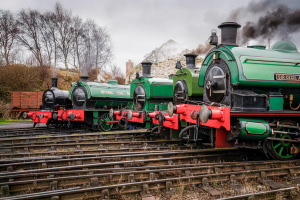
In its later years it carried some passenger traffic as well, but was closed in 1964. Marley Hill engine shed was open until 1970 and was then taken over by volunteers who prepared a number of steam locos. Limited running started in 1973 leading up to the full opening of the line through to East Tanfield in 1992. To celebrate their tricentenary the energetic people at the Tanfield Railway built a replica wooden cauldron wagon, and invited the oldest working steam locomotive in the UK to join the resident 5 steam locomotives on the day. What's more, they managed to get a 30 minute film about their railway shown on BBC 2 - now available on the BBC iPlayer.
Restoration Awards
Jeremy Craske - 1921 Fowler Steam Roller
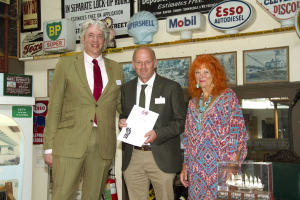
Jeremy Craske, from Thirsk in North Yorkshire, receives this award, and also the Sir Peter Allen Commemorative award, for the restoration of a 1921 Fowler steam roller - a machine that once played a pioneering role in early road-building technology.
This steam roller originally featured two significant components: a tar sprayer and a rotary sweeping brush. These attachments made it one of the earliest machines used to both prepare and seal roads during Britain's transition to tarred surfaces and in fact, this may well have been the prototype for Fowler's "Improved Tar Spraying Apparatus."  Jeremy's family has owned the roller since 1971, after rescuing it from scrap condition at a quarry in Leyburn. It was carefully restored to working order and driven back to their home base, where it has been part of an extraordinary educational display ever since - complete with lamps, barriers, signage, and even a rare towed gritter.
Jeremy's family has owned the roller since 1971, after rescuing it from scrap condition at a quarry in Leyburn. It was carefully restored to working order and driven back to their home base, where it has been part of an extraordinary educational display ever since - complete with lamps, barriers, signage, and even a rare towed gritter.
While the tar-spraying equipment was successfully replaced after a 30-year search, Jeremy's current focus is to recreate the rotary brush - a component now believed to survive on no other roller. He has already sourced the original blueprints, commissioned pitch-set cylindrical brushes, and assembled many of the smaller components.
But the engineering needed to fabricate the clutch, levers, framework, and chain drive is beyond Jeremy's means and equipment. The restoration is currently paused, and a boost like today's award would provide vital encouragement to restart the work, with the aim of finishing by 2027 or 2028.
What makes this project so special is that it's not just about preserving a machine - it's about creating a working, moving demonstration of early 20th-century road repair, complete with period accessories and community outreach. Jeremy takes the roller to local steam fairs and events, where it teaches and inspires both adults and children alike.
 For his dedication, historical accuracy, and hands-on commitment to preserving this lost piece of roadwork history, we are pleased to honour Jeremy Craske with this award.
For his dedication, historical accuracy, and hands-on commitment to preserving this lost piece of roadwork history, we are pleased to honour Jeremy Craske with this award.
Simon Barringer - 1929 BSA Front-Wheel Drive Three-Wheeler
This year, the Ron Wilsdon Award is made to Simon Barringer, from Little Witley in Worcestershire, who receives his award for the restoration of a 1929 BSA front-wheel drive three-wheeler, a vehicle that marked a breakthrough in early motoring.
 The BSA three-wheeler was the first mass-produced car to feature front-wheel drive and all-independent suspension, years ahead of its time. It was marketed as a light, affordable car that could be driven on a motorcycle licence, opening up personal transport to a whole new group of people.
The BSA three-wheeler was the first mass-produced car to feature front-wheel drive and all-independent suspension, years ahead of its time. It was marketed as a light, affordable car that could be driven on a motorcycle licence, opening up personal transport to a whole new group of people.
Simon's particular vehicle is believed to be the 226th ever built, and he's restoring it with a replica Avon two-seater roadster body making it the only known survivor with this style of coachwork.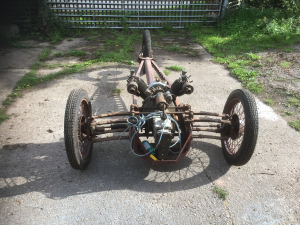
The project began with a dismantled chassis and a pile of parts. But Simon, an upholsterer by trade, has transformed it into a high-quality restoration. The chassis, wheels, engine, gearbox, and dashboard are all original, restored with care and attention. The coachwork has been rebuilt from scratch using traditional methods, and will soon feature fabric covering, leather seats, and a split windscreen.
He's also handled the mechanical restoration including rebuilding the engine and gearbox, while outsourcing only the most specialist tasks, such as bearing work.
Importantly, Simon doesn't plan to hide the car away. He already competes in vintage trials and rallies with another BSA trike, and this one will join it. His goal is to use and share the car, bringing it to life in the same way it once brought independence and freedom to post-war motorists.  Simon expects to complete the project by the end of the year. We're pleased to support this meticulous and deeply personal restoration - one that celebrates early innovation, accessibility, and engineering ingenuity.
Simon expects to complete the project by the end of the year. We're pleased to support this meticulous and deeply personal restoration - one that celebrates early innovation, accessibility, and engineering ingenuity.
Roy Gudge & Phil Sawkins - 1960 Bedford Plaxton Coach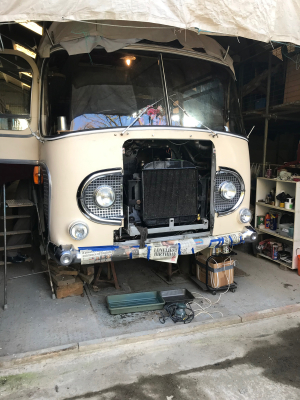
Roy Gudge, from Farnham in Surrey, and Phil Sawkins, working in Milland in Hampshire, receive an award for the restoration of a 1960 Bedford J4L Plaxton Embassy coach, affectionately known by its registration number 999 PPL.
This coach was originally operated by Comfy Coaches, a family-run business founded by Roy's grandfather in 1925. It served routes across Surrey and Hampshire, and even appeared in the 1961 British Coach Rally, where it won the Vigzol Tankard.  The coach was sold after the business closed in 1962, and for decades, its fate was unknown. Then, in 1994, Roy's family tracked it down and re-purchased it, beginning a challenging and long-running restoration journey that would last over 20 years.
The coach was sold after the business closed in 1962, and for decades, its fate was unknown. Then, in 1994, Roy's family tracked it down and re-purchased it, beginning a challenging and long-running restoration journey that would last over 20 years.
The vehicle was stored at several locations, often outdoors, and had suffered from a persistent roof leak dating back to its construction. But Roy, Phil, and their friends have taken on the enormous task of rebuilding much of the wooden frame, restoring the aluminium trim, repainting the coach in its original colours, and completing many mechanical repairs.
The engine is run regularly to keep it healthy. The seat upholstery is now a work in progress, using the correct moquette sourced after an extended search. Despite a tight budget and extensive work, they've stuck to their goal of restoring the coach as close to its original specification as possible.  What's more, the project is intended not just for private enjoyment. The coach will be shown at vintage vehicle events and has a confirmed future home in a newly planned public motor museum, opening in 2026.
What's more, the project is intended not just for private enjoyment. The coach will be shown at vintage vehicle events and has a confirmed future home in a newly planned public motor museum, opening in 2026.
The National Transport Trust is delighted to present this award in recognition of over two decades of determination, historical care, and hands-on work. It's a tribute to the preservation of post-war transport, and to a coach that once proudly served its community.
Simon Hartshorne - Baby Deltic Locomotive Recreation
This year the David Muirhead Award is made to Simon Hartshorne, from Twyford near Derby, who receives a Restoration Award for one of the most technically ambitious and historically meaningful projects in recent railway preservation: the recreation of the long-lost British Rail Class 23 "Baby Deltic" locomotive.  Only ten of these compact diesel-electric locomotives were built in the late 1950s as part of British Rail's push to modernise. Known as the Baby Deltics, they were powered by a 9-cylinder Napier Deltic engine and were intended to be a smaller, more versatile counterpart to the now-famous Class 55s. Though innovative, they had a short working life, and by the early 1970s, all had been scrapped. Not one original Baby Deltic survived - until now.
Only ten of these compact diesel-electric locomotives were built in the late 1950s as part of British Rail's push to modernise. Known as the Baby Deltics, they were powered by a 9-cylinder Napier Deltic engine and were intended to be a smaller, more versatile counterpart to the now-famous Class 55s. Though innovative, they had a short working life, and by the early 1970s, all had been scrapped. Not one original Baby Deltic survived - until now.  Simon, alongside a small and determined team of volunteers, set out to reverse that loss. Working primarily at Barrow Hill Roundhouse, they undertook the extraordinary task of building a working Baby Deltic from scratch. Using a shortened Class 37 chassis as the base, the team sourced the only surviving 9-cylinder Napier Deltic engine and engineered the rest themselves from recreating the bodywork to fabricating entirely new cooling systems and adapting bogies and control gear. This wasn't just a cosmetic replica. Every element of this project has been driven by accuracy, functionality, and an uncompromising standard of historical fidelity. Components from numerous donor locomotives were adapted, custom-built assemblies were fabricated to original specs, and engineering challenges, such as fitting the compact Deltic engine and redesigning internal layouts, were solved with creativity and professionalism.
Simon, alongside a small and determined team of volunteers, set out to reverse that loss. Working primarily at Barrow Hill Roundhouse, they undertook the extraordinary task of building a working Baby Deltic from scratch. Using a shortened Class 37 chassis as the base, the team sourced the only surviving 9-cylinder Napier Deltic engine and engineered the rest themselves from recreating the bodywork to fabricating entirely new cooling systems and adapting bogies and control gear. This wasn't just a cosmetic replica. Every element of this project has been driven by accuracy, functionality, and an uncompromising standard of historical fidelity. Components from numerous donor locomotives were adapted, custom-built assemblies were fabricated to original specs, and engineering challenges, such as fitting the compact Deltic engine and redesigning internal layouts, were solved with creativity and professionalism.
The result is not only technically impressive, but emotionally resonant. For railway heritage, the Baby Deltic project restores a lost link in the story of British diesel development. And for younger generations, it demonstrates that major heritage engineering projects can still be led by skilled volunteers working together.
Now more than 85% complete, the locomotive is close to running and has already become a focal point in the heritage diesel community. Its public debut will be a major event - the first time a Baby Deltic will move under its own power in over 50 years.  For engineering excellence, vision, and sheer tenacity, we are proud to honour Simon Hartshorne with this award.
For engineering excellence, vision, and sheer tenacity, we are proud to honour Simon Hartshorne with this award.
Zach Fields-Pattinson - Fowler BB1 'Victory' Steam Ploughing Engine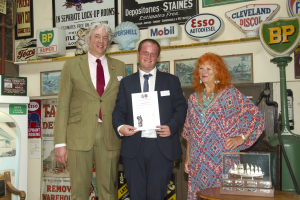
A Restoration Award is made to Zach Fields-Pattinson, from Bramshall near Uttoxeter in Staffordshire, for his remarkable restoration of the 1919 Fowler BB1 steam ploughing engine 'Victory'.
Zach began this restoration at just 23 years old - an age when most are still learning their trade. With no formal engineering training, and working primarily alone and on a limited income, he took on one of the most demanding and specialist projects in steam preservation: the full restoration of a heavy-duty steam ploughing engine, used in agricultural and land drainage work in the early 20th century.  'Victory' had spent decades rusting in a field. When Zach acquired it, the engine was in poor shape with significant boiler corrosion, seized components, and many missing parts. Yet he didn't shy away. With immense determination, Zach committed himself to learning the necessary skills including metal fabrication, machining, riveting, boiler work and historical research.
'Victory' had spent decades rusting in a field. When Zach acquired it, the engine was in poor shape with significant boiler corrosion, seized components, and many missing parts. Yet he didn't shy away. With immense determination, Zach committed himself to learning the necessary skills including metal fabrication, machining, riveting, boiler work and historical research.
Over several years, he rebuilt major boiler sections to professional standards, restored the running gear and motion, and fabricated replacement fittings from scratch, using historical references and original Fowler blueprints.
The BB1 is a rare and unusual model. 'Victory' features a longer-than-normal winch drum and was originally used for draining land making it one of the few surviving examples of a steam engine built for this very specific kind of agricultural application. That historical rarity makes Zach's achievement even more significant.
He has remained scrupulously faithful to the original design. Rather than taking shortcuts, he has worked slowly and steadily often re-making parts until they met the original tolerances and specifications. And all of this, remarkably, has been done at home in his own small workshop and with the help of a few friends in the steam preservation community.  Zach's story is a powerful reminder of what young people can accomplish in heritage restoration. It's not only a celebration of craftsmanship, but a signal to the next generation that even the biggest machines can be brought back to life with passion and patience.
Zach's story is a powerful reminder of what young people can accomplish in heritage restoration. It's not only a celebration of craftsmanship, but a signal to the next generation that even the biggest machines can be brought back to life with passion and patience.
We are proud to recognise his outstanding work and inspiring journey with this award.
John Draysey - 1974 Range Rover Carmichael 6x4 Fire Engine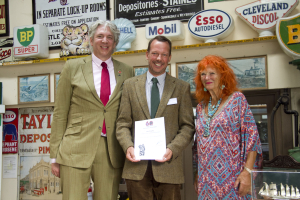
This Restoration Award is presented to John Draysey, from Godalming in Surrey, for the restoration of a rare and historically meaningful 1974 Range Rover Carmichael 6x4 Fire Engine - a vehicle with a personal connection and a community purpose.
John's interest in this vehicle began in childhood, when he saw the original fire engine in action, fighting local fires as part of the West Sussex Fire Brigade. It left a lasting impression, so much so that John began collecting memorabilia of it, including a postcard featuring the engine, which he's kept since he was eight years old.  Years later, the very same Range Rover Carmichael reappeared but in rough condition, having been used in industrial fire cover and stored outdoors overseas. Most would have walked away, but John saw an opportunity to preserve not just a machine, but a memory, and to use it as a powerful tool for education and public engagement.
Years later, the very same Range Rover Carmichael reappeared but in rough condition, having been used in industrial fire cover and stored outdoors overseas. Most would have walked away, but John saw an opportunity to preserve not just a machine, but a memory, and to use it as a powerful tool for education and public engagement.
The Carmichael 6x4 conversion is a rare and specialist variant of the Range Rover Classic. Designed for off-road fire response, it features a third axle, water tank, pump system, and extended bodywork. John's restoration has focused on preserving its originality while returning it to working condition.
He has taught himself welding, sourced rare parts through online forums and salvage yards, and painstakingly recreated period features including the livery, signage, and blue lights. The mechanical restoration has involved brake systems, electrics, and structural repairs, all done at home with modest tools and a huge amount of dedication.  Importantly, John sees the restored fire engine not as a showpiece, but as a platform. He plans to use it at public events, heritage days, and school visits to promote fire safety and community awareness - a living tribute to the engine's original role.
Importantly, John sees the restored fire engine not as a showpiece, but as a platform. He plans to use it at public events, heritage days, and school visits to promote fire safety and community awareness - a living tribute to the engine's original role.
This is a project rooted in personal history, technical skill, and social purpose. For his commitment to bringing a childhood inspiration back to life and making it relevant again for a new generation, we are delighted to recognise John Draysey with this award.
Rob Broadhurst - Project Getaway Restoration App & 1966 Jaguar Mk2
The final mention for this year is a Highly Commended Award, given to Rob Broadhurst for his innovative development of a digital restoration platform, known as Project Getaway, and its application through the restoration of a 1966 Jaguar Mk2 3.8.
Rob's project stood out for its originality, its embrace of digital tools, and its potential to support and modernise the entire heritage vehicle restoration community.  Rather than simply documenting his Jaguar's rebuild through traditional means, Rob has created a structured, interactive platform to catalogue every step of the process from disassembly and inspection, through to refurbishment and reassembly. The app allows restorers to assign condition grades, set task priorities, track supplier orders, and monitor time, cost, and effort.
Rather than simply documenting his Jaguar's rebuild through traditional means, Rob has created a structured, interactive platform to catalogue every step of the process from disassembly and inspection, through to refurbishment and reassembly. The app allows restorers to assign condition grades, set task priorities, track supplier orders, and monitor time, cost, and effort.
What makes this particularly impressive is that the Jaguar Mk2 project has served as a real-world testbed for the system. As the app evolves, so too has the car - a 3.8 manual with overdrive, complete with its original Surrey registration. Rob has used the system to manage restoration phases, record work with photographic evidence, and assess component condition with the goal of developing a tool that others can adopt, customise, and expand.
With decades of experience in both restoration and software development, Rob has created something unique: a system that blends craft and code, and which could help streamline complex projects, avoid errors, and preserve knowledge for future enthusiasts.  Project Getaway is still evolving but its potential is clear. As more restorers digitise their workflows, this platform could become a cornerstone for planning, collaboration, and education in the preservation world.
Project Getaway is still evolving but its potential is clear. As more restorers digitise their workflows, this platform could become a cornerstone for planning, collaboration, and education in the preservation world.
We commend Rob not only for his personal project, but for his foresight and contribution to the future of restoration. For this, he receives a Highly Commended recognition from the National Transport Trust.
The National Transport Trust makes loans to groups, associations and individuals at advantageous rates for the restoration of artefacts - whether mobile or part of the infrastructure. Applications must be supported by a simple business plan which demonstrates the financial viability of the project. A sample business plan is available on request from the Treasurer.
The Trust does occasionaly make Awards for schemes which further the preservation movement. Again if you wish further information please contact the Treasurer.